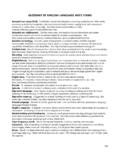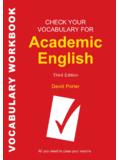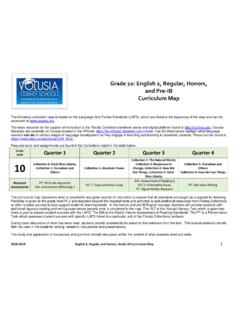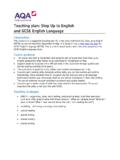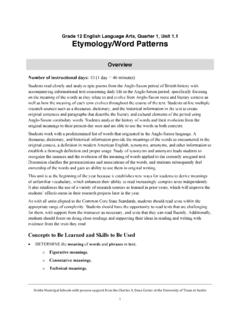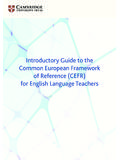Transcription of Guidelines for Designing Effective English …
1 Guidelines for Designing Effective English Language Teaching Materials Jocelyn Howard Christchurch College of Education Jae Major Christchurch College of Education Abstract There are many reasons why English language teachers may choose to construct their own teaching materials, despite the availability of commercially produced materials. This paper presents some of these reasons by examining advantages and disadvantages of teacher-produced materials. The authors also suggest factors that teachers should take into account when Designing or adapting materials for diverse learners, and present a set of Guidelines for Designing Effective materials for teaching and learning English . Introduction Teaching materials form an important part of most English teaching programmes. From textbooks, videotapes and pictures to the Internet, teachers rely heavily on a diverse range of materials to support their teaching and their students' learning. However, despite the current rich array of English language teaching materials commercially available, many teachers continue to produce their own materials for classroom use.
2 Indeed, most teachers spend considerable time finding, selecting, evaluating, adapting and making materials to use in their teaching. In this paper we synthesise a range of ideas from the literature on materials design. We consider why teachers might want to design their own teaching materials and look at some of the advantages and disadvantages. We examine six factors that teachers need to take into account when considering Designing their own materials; and finally we present ten Guidelines for Designing Effective English teaching materials. Why English Language Teachers May Choose to Design their own Materials Advantages Discussions about the advantages and disadvantages of teacher-designed materials usually centre on a comparison with using text or coursebooks. Rather than focusing on coursebooks, we have turned our focus to teacher-produced materials and consider that the disadvantages of coursebooks can become advantages for teacher-produced materials.
3 The key reasons why teachers may wish to produce their own teaching materials can be linked to four themes distilled from recent literature on this topic ( , Altan, 1995; Block, 1991; Harmer, 2001; Podromou, 2002; Thornbury & Meddings, 2001, 2002). An important advantage of teacher-produced materials is contextualisation (Block, 1991). A key criticism of commercial materials, particularly those produced for the world-wide EFL. market is that they are necessarily generic and not aimed at any specific group of learners or any particular cultural or educational context. The possible lack of fit' between teaching context and coursebook has been expressed thus: Our modern coursebooks are full of speech acts and functions based on situations which most foreign-language students will never encounter Globally'. designed coursebooks have continued to be stubbornly Anglo-centric. Appealing to the world market as they do, they cannot by definition draw on local varieties of English and have not gone very far in recognising English as an international language, either.
4 (Altan, 1995, p. 59). For many teachers, Designing or adapting their own teaching materials, enables them to take into account their particular learning environment and to overcome the lack of fit' of the coursebook. Another aspect of context is the resources available. Some teaching contexts will be rich in resources such as coursebooks, supplementary texts, readers, computers, audio-visual 101. equipment and consumables such as paper, pens and so on. Other contexts may be extremely impoverished, with little more than an old blackboard and a few pieces of chalk. A lack of commercial materials forces teachers to fall back on their own resources and Designing their own teaching materials can enable them to make best use of the resources available in their teaching context. A further aspect that is not often mentioned in the literature is the cost of commercially produced resources. For many schools, teacher-produced materials can be the best option in terms of both school and student budget.
5 A second area in which teacher-designed materials are an advantage is that of individual needs. Modern teaching methodology increasingly emphasises the importance of identifying and teaching to the individual needs of learners. English language classrooms are diverse places not only in terms of where they are situated, but also in terms of the individual learners within each context. Teacher-designed materials can be responsive to the heterogeneity inherent in the classroom. This approach encompasses the learners' first languages and cultures, their learning needs and their experiences. Few coursebooks deliberately incorporate opportunities for learners to build on the first language skills already acquired, despite research suggesting that bilingual approaches are most successful in developing second language competence (Thomas & Collier, 1997). A teacher can develop materials that incorporate elements of the learners' first language and culture, or at least provide opportunities for acknowledgement and use alongside English .
6 In addition, teacher-prepared materials provide the opportunity to select texts and activities at exactly the right level for particular learners, to ensure appropriate challenge and levels of success. In Designing their own materials teachers can also make decisions about the most appropriate organising principle or focus for the materials and activities. And this can be changed over the course of the programme if necessary. Most coursebooks remain organised around grammar elements and the PPP (presentation, practice, production) model of teaching, often with an unrelenting format which can be deeply unengaging (Harmer, 2001, p. 6). By taking more control over materials production, teachers can choose from the range of possibilities, including topics, situations, notions, functions, skills etc, or a combination of these principles, as starting points to develop a variety of materials that focus on the developing needs of their particular group of learners.
7 Personalisation is another advantage of teacher-designed materials. In his 1991 article, Block argues in favour of home-made' materials saying that they add a personal touch to teaching that students appreciate. Tapping into the interests and taking account of the learning styles of students is likely to increase motivation and engagement in learning. Podromou (2002) further suggests that there is also greater choice, freedom and scope for spontaneity when teachers develop their own materials. A further advantage of teacher-designed materials is timeliness (Block, 1991). Teachers Designing their own materials can respond to local and international events with up-to-date, relevant and high interest topics and tasks. The teachable moment can be more readily seized. In conclusion, the advantages of teacher-designed materials can be summed up in the idea that they avoid the one-size-fits-all' approach of most commercial materials. Disadvantages There are a number of potential pitfalls for teachers who would be materials designers.
8 These can be considered under three headings, the first of which is organisation. Coursebooks are usually organised around an identifiable principle and follow a discernible pattern throughout. While this can be rather dull and boring (or unrelenting') it does provide both teachers and students with some security and a coherent body of work to remember and revise from (Harmer, 2001, p. 7). In contrast, teacher-designed materials may lack overall coherence and a clear progression. Without some overall organising principle, materials may be piecemeal and can result in poorly focused activities lacking clear direction. This is frustrating and confusing for learners who may not be able to see how their English is developing. A further aspect of organisation relates to the physical organisation and storage of materials. Without a clearly thought through and well-organised system, teacher-produced materials may be difficult to locate for ongoing use, or may end up damaged or with parts missing.
9 102. Possibly the most common criticism levelled against teacher-made materials is to do with their quality. At the surface level, teacher-made materials may seem ragged and unprofessional next to those produced by professionals. (Block, 1991, p. 212, emphasis in original). They may contain errors, be poorly constructed, lack clarity in layout and print and lack durability. Harmer probably speaks for many when he says, If the alternative is a collection of scruffy photocopies, give me a well-produced coursebook any time. (2001, p. 7). In addition, a lack of experience and understanding on the part of the teacher may result in important elements being left out or inadequately covered. Teacher-made materials may be produced to take advantage of authentic text. However, if not guided by clear criteria and some experience, teachers may make inconsistent or poor choices of texts. A further problem may be a lack of clear instructions about how to make Effective use of the materials particularly instructions designed for students.
10 Yet another disadvantage of teacher-made materials, and perhaps the key factor inhibiting many teachers from producing their own teaching materials, is time. However passionately one may believe in the advantages of teacher-designed materials, the reality is that for many teachers, it is simply not viable at least not all the time. Factors to Consider When Designing Materials We turn now to consider six key factors that teachers need to take into account when embarking on the design of teaching materials for their learners. These relate to, and refer back to some of the advantages and disadvantages. Some will also be expanded further in the Guidelines which follow. The first and most important factor to be considered is the learners. If the point of teacher-created materials is relevance, interest, motivation and meeting specific individual needs, then clearly teachers must ensure they know their learners well. Any consideration of syllabus or materials design must begin with a needs analysis.
